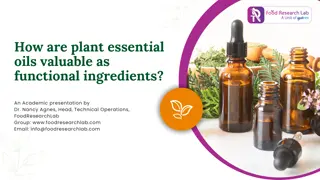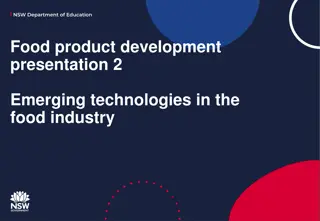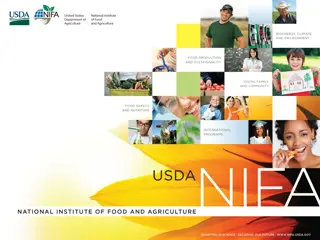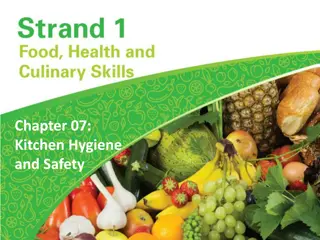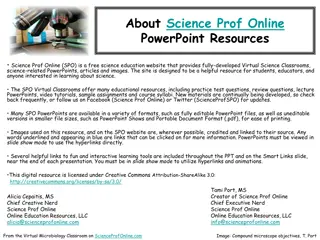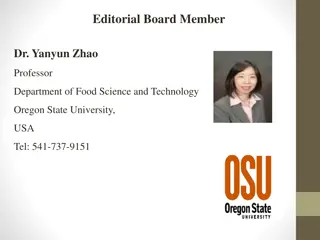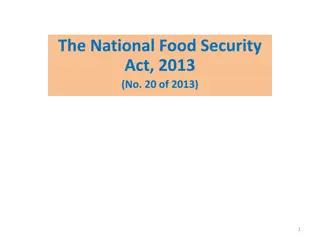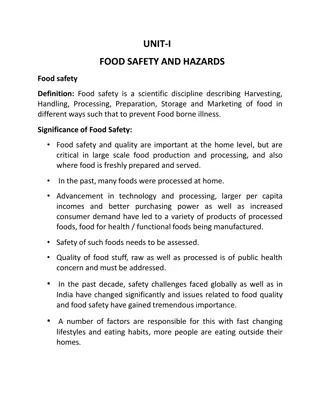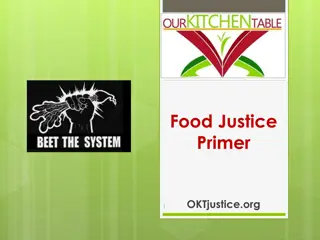Exploring Food Science and Technology Learning Opportunities
Dive into the world of food science and technology with engaging lessons covering topics such as food safety, nutrition, and sensory properties. Discover the importance of teaching food science, explore themed lessons suitable for remote delivery, and understand the relevance of food science schemes to NGSS. Get hands-on with activities like examining sugar substitutes and analyzing the sensory properties of food. Elevate your knowledge of food science before college and unleash your culinary curiosity!
Download Presentation

Please find below an Image/Link to download the presentation.
The content on the website is provided AS IS for your information and personal use only. It may not be sold, licensed, or shared on other websites without obtaining consent from the author. Download presentation by click this link. If you encounter any issues during the download, it is possible that the publisher has removed the file from their server.
E N D
Presentation Transcript
Glen Li OSU Food Science and Technology FOOD SCIENCE LESSONS
LEARNING FOOD SCIENCE BEFORE COLLEGE - UNIQUE OPPORTUNITIES See samonella? Food safety Outbreaks, recalls Nutrition Healthy diet, healthy eating habits Malnutrition epidemic Environment protection Marketing claims in consumer foods Formation of regulations and policies Engaging and fun!
WHY TEACH FOOD SCIENCE? Contextualizing science via food science Chemistry Biology (and microbiology) Engineering Inspiring students to become food scientists and technologists Those with culinary interest Foodies Research in chemistry, human health, etc.
THREE FOOD-SCIENCE THEMED LESSONS SUITABLE FOR REMOTE DELIVERY 1 - Sweet Jell-O's Examine the sensory properties of sugar substitutes 2 Quick bread Experiment with different recipes, and analyze how different recipes affect yeast 3 Moldy bread Identify the connection between storage condition and food spoilage
FOOD SCIENCE SCHEMES AND NGSS Sensory Science Scale, proportion, and quantity (CCC) Fermentation and Food Processing Chemical Reactions Food Safety and Sanitation Cause and effect
SUGAR SUBSTITUTES: HOW SWEET ARE THEY? Sweeter Sweetness compared to table sugar Coconut sugar Same Fructose > 1.5 Maple syrup 0.5 Sweet n Low (saccharin) 300-400 Truvia (erythritol) 0.6-0.7 Sucralose 320-1000 Neotame ~8000
DIMENSIONS OF SENSORY PROPERTIES Texture Mouthfeel Sweetness Aftertaste
POSSIBLE QUESTIONS FROM YOUR CLASS More sweetness = less healthy? Not necessarily Do sugar substitutes contain sugar? Dextrose (a.k.a. glucose), dextrin, and maltooligosaccharides are common ingredients
ACTIVITY 2: NO KNEAD BREAD, IN 10 MINUTES? Control group Cooked yeast Microwave yeast granule high, 1 min Hydrated yeast 100 F water, 5 minutes Adding table sugar sucrose Adding soda beverage (e.g. Sprite) fructose
EFFECT OF YEAST METABOLISM ON BAKING Hydration in warm water helps yeast adapt to changes in osmotic pressure Microwave (this would kill the yeast) Addition of nutrients (fructose, sucrose) Sugars can be metabolized by yeast as carbon source Boosts CO2 generation and leavening
ACTIVITY 3: MOLDY BREAD You may use the leftover bread from Activity 2
QUESTIONS TO EXPECT FROM STUDENTS Where does the mold come from? Mold spores are common in our living environment They grow into mold under favorable conditions Can I still eat it? Allergen Toxins How can we suppress mold growth? Antifungal food additives Food sanitation practices






